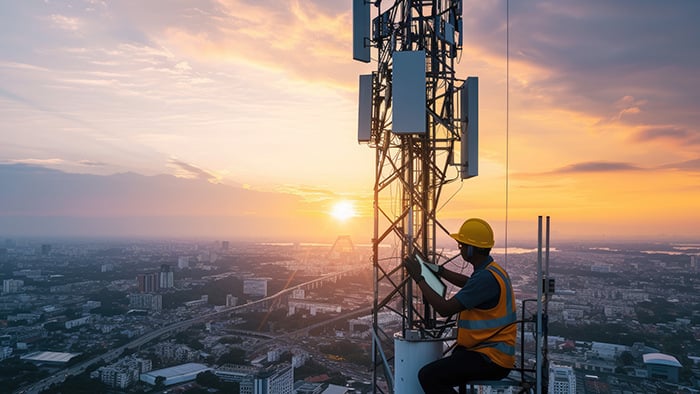What is 5G UC?
5G UC means “5G Ultra Capacity,” and it's T-Mobile’s advanced version of 5G. 5G UC represents a faster standard (compared to a Local Area Network) and includes high-band 5G, but it also relies on mid-band spectrums, particularly the 2.5 GHz frequency. You’ll see the 5G UC icon on your phone’s status bar if you're in the range of one of the towers.
T-Mobile’s approach to implementing 5G across the United States means their customers have two types of 5G service. The first is Extended Range 5G, a low-band network that provides 5G coverage to as many locations as possible and shows up on your phone simply as “5G.”
The second type, which is being enabled more gradually, is Ultra Capacity 5G. 5G UC can use high-band frequencies, such as millimeter wave (mmWave), allowing for even greater bandwidth.
If you see the standard 5G symbol, you’re connected to a low-band network. But if you see 5G UC, you’re connected to a mid or high-band network.
What's the difference between 5G, 5G UW, and 5G Plus?
As 5G UC only refers to the T-Mobile network, users of other providers may see other icons or different names for equivalent 5G networks. Here’s what popular cell network providers use to refer to 5G networks:
|
|
T-Mobile
|
Verizon
|
AT&T
|
|
Low-band 5G name
|
Extended Range
|
Nationwide 5G
|
5G
|
|
Low-band icon
|
5G
|
5G
|
5G
|
|
Mid- or High-band name
|
Ultra Capacity
|
Ultra Wideband
|
5G UW or 5G UWB
|
|
Mid- or High-band icon
|
5G UC
|
5G Plus
|
5G+
|
Another type you may notice is 5GE (Evolution), which some consider a controversial marketing name AT&T uses for its 4G LTE that does not actually provide a 5G service.
Which phones support 5G UC?
Most 5G compatible phones that use the T-Mobile network can pick up 5G UC, but access will depend on the phone’s location.
iPhones that support 5G UC
For Apple users, the iPhone 12 (2020) or newer models support 5G UC, such as:
-
iPhone 12 (including Mini, Pro, Pro Max)
-
iPhone 13 (including Mini, Pro, Pro Max)
-
iPhone SE (3rd Gen)
-
iPhone 14 (including Plus, Pro, Pro Max)
-
iPhone 15 (including Plus, Pro, Pro Max)
Samsung phones that support 5G UC
Android users with a Samsung can also benefit from 5G UC. Here are some Samsung models that can reliably connect:
-
Galaxy S20 (including S20+, S20 Ultra, S20 FE)
-
Galaxy Z Flip
-
Galaxy Note20 5G & Note20 Ultra
-
Galaxy Fold2
-
Galaxy Fold3
-
Galaxy Fold4
-
Galaxy Fold5
-
Galaxy A42
-
Galaxy S21 (including S21+, S21 Ultra)
Google phones that support 5G UC
Pixel phones from the Pixel 4a onward are also compatible with 5G UC, such as:
-
Pixel 4a (5G)
-
Pixel 5 & 5a
-
Pixel 6 & 6a
-
Pixel 7 & 7a
-
Pixel Fold
-
Pixel 8 & 8 Pro
Is 5G UC better than regular 5G?
5G UC networks offer faster speeds compared to other types of 5G and 4G networks and have the potential to be as fast as reliable Wi-Fi, but this varies depending on signal strength and location. Most large cities usually have better performance while rural areas can often have poorer network coverage due to the limited frequency range.
Many providers use the label 5G for their slowest 5G services, which commonly use existing 4G LTE networks limited to speeds of around 1Gbps. If you want to get the fastest possible connection speeds for your phone, look out for 5G UC or your network provider’s high-band equivalent. Currently, 5G UC has a peak data rate of around 3Gbps, which is expected to increase as the network grows.
Get ultimate antivirus protection for your phone
Why stop at better network cell service when you can also optimize your device and protect it from online threats? Avast One helps block malicious threats from being installed on your phone, letting you browse more safely. It also includes a VPN to encrypt your connection and hide your online activity. Install Avast One today for comprehensive device performance and security.
FAQs
Does 5G UC use more battery?
Using 5G UC or 5G can result in increased battery usage. Many current 5G networks are non-standalone, which means you’re connected to 4G and 5G simultaneously — this can use more battery. 5G UC might also use more battery if the service is weak and your phone is bouncing from tower to tower searching for a signal.
Why is my 5G UC slow?
If you’re having difficulty with slow speeds, it could be due to the network coverage in your area — 4G LTE can sometimes offer better strength and faster performance than a weak 5G signal. Slow performance can also be due to the device itself. Check out our guides to speeding up your iPhone and Android devices.
Can I turn 5G UC off?
You can't turn 5G UC off, but you can switch between 4G and 5G networks in your phone's mobile network settings. Here’s where to find and adjust the network settings on your phone:
What band does 5G UC use?
In the same way that radio stations use different frequencies, mobile services operate using different ranges (bands) on the radio frequency (RF) spectrum.
The following bands can provide 5G UC:
-
Band n41 (2.5 GHz)
-
Band n258 (24 GHz)
-
Band n260 (39 GHz)
-
Band n261 (28 GHz)














